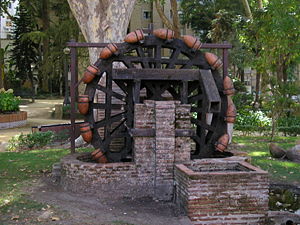The global economy established from the 8th century to the 13th century by Arab and other Muslim traders across the Old World, enabled the diffusion of many crops and farming techniques among different parts of the Islamic world, as well as the adaptation of crops and techniques from and to regions beyond the Islamic world. Crops from Africa such as sorghum, crops from China such as citrus fruits, and numerous crops from India such as mangos, rice, and especially cotton and sugar cane, were distributed throughout Islamic lands, which previously had not grown these crops. These introductions, along with an increased mechanization of agriculture, led to major changes in economy, population distribution, vegetation cover, agricultural production and income, population levels, urban growth, the distribution of the labor force, linked industries, cooking, diet and clothing in the Islamic world.

|
The Green Revolution refers to the transformation of agriculture that began in 1945 at the request of the Mexican government to establish an agricultural research station to develop more varieties of wheat that could be used to feed the rapidly growing population of the country. In 1943 Mexico imported half its wheat; in 1956, the Green Revolution had made Mexico self-sufficient; by 1964, Mexico exported half a million tons of wheat.
India soon adopted IR8 - a rice semi-dwarf variety that could produce more grains of rice per plant when grown properly with fertilizer and irrigation. It could yield about 5 tons per hectare with no fertilizer, and almost 10 tons per hectare under optimal conditions, 10 times the yield of traditional rice. In the 1960s, rice yields in India were about two tons per hectare; by the mid-1990s, they had risen to six tons per hectare. In the 1970s, rice cost about $550 a ton; in 2001, it cost less than $200 a ton. India became one of the world's most successful rice producers, and is now a major rice exporter, shipping nearly 4.5 million tons in 2006. IR8 required the use of fertilizers and pesticides, but annual rice production in the Philippines increased from 3.7 to 7.7 million tonnes in the two decades since it was introduced there in 1962.
Other crops increased yields, which, not only alleviated the level of hunger, but simultaneously released the human population from the nutritional obstacle to further growth. Continued growth demands ever more agricultural improvements. As prime agricultural land is converted to habitation, governments clear the biodiverse native landscape for less diverse farms. Natural or political calamities could rapidly lead to starvation.
Excerpted and adapted from: Muslim Agricultural Revolution and Green Revolution